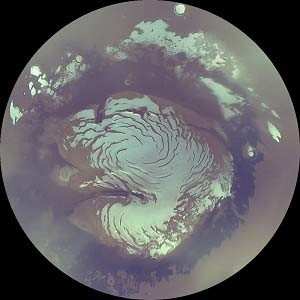May Need To Drill Deeper For Water As A Result
 New observations from NASA's Mars
Reconnaissance Orbiter indicate that the crust and upper mantle of
Mars are stiffer and colder than previously thought. The findings
suggest any liquid water that might exist below the planet's
surface and any possible organisms living in that water, would be
located deeper than scientists had suspected.
New observations from NASA's Mars
Reconnaissance Orbiter indicate that the crust and upper mantle of
Mars are stiffer and colder than previously thought. The findings
suggest any liquid water that might exist below the planet's
surface and any possible organisms living in that water, would be
located deeper than scientists had suspected.
"We found that the rocky surface of Mars is not bending under
the load of the north polar ice cap," said Roger Phillips of the
Southwest Research Institute in Boulder, CO. Phillips is the lead
author of a new report appearing in this week's online version of
Science. "This implies that the planet's interior is more rigid,
and thus colder, than we thought before."
The discovery was made using the Shallow Radar (SHARAD)
instrument on the Orbiter, which has provided the most detailed
pictures to date of the interior layers of ice, sand and dust that
make up the north polar cap on Mars. The radar images reveal long,
continuous layers stretching up to 600 miles or about one-fifth the
length of the United States.
"In our first glimpses inside the polar ice using the radar on
Mars Reconnaissance Orbiter, we can clearly see stacks of icy
material that trace the history of Mars' climate," said Jeffrey
Plaut from NASA's Jet Propulsion Laboratory in Pasadena, CA. Plaut
is a science team member and a co-author of the paper. "Radar has
opened up a new avenue for studying Mars' past."
The radar pictures show a smooth, flat border between the ice
cap and the rocky Martian crust. On Earth, the weight of a similar
stack of ice would cause the planet's surface to sag. The fact that
the Martian surface is not bending means that its strong outer
shell, or lithosphere, a combination of its crust and upper mantle,
must be very thick and cold.
"The lithosphere of a planet is the rigid part. On Earth, the
lithosphere is the part that breaks during an earthquake," said
Suzanne Smrekar, deputy project scientist for Mars Reconnaissance
Orbiter at JPL. "The ability of the radar to see through the ice
cap and determine that there is no bending of the lithosphere gives
us a good idea of present day temperatures inside Mars for the
first time."
Temperatures in the outer portion of a rocky planet like Mars
increase with depth toward the interior. The thicker the
lithosphere, the more gradually the temperatures increase. The
discovery of a thicker Martian lithosphere therefore implies that
any liquid water lurking in aquifers below the surface would have
to be deeper than previously calculated, where temperatures are
warmer. Scientists speculate that any life on Mars associated with
deep aquifers also would have to be buried deeper in the
interior.
The radar pictures also reveal four zones of finely spaced
layers of ice and dust separated by thick layers of nearly pure
ice. Scientists think this pattern of thick ice-free layers
represents cycles of climate change on Mars on a time scale of
roughly one million years. Such climate changes are caused by
variations in the tilt of the planet's rotational axis and in the
eccentricity of its orbit around the sun. The observations support
the idea that the north polar ice cap is geologically active and
relatively young, at about 4 million years.

On May 25, NASA's Phoenix Mars Lander is scheduled to touch down
not far from the north polar ice cap. It will further investigate
the history of water on Mars, and is expected to get the first up
close look at ice on the Red Planet.
 SpaceX to Launch Inversion RAY Reentry Vehicle in Fall
SpaceX to Launch Inversion RAY Reentry Vehicle in Fall Aero-News: Quote of the Day (04.23.24)
Aero-News: Quote of the Day (04.23.24) Aero-News: Quote of the Day (04.20.24)
Aero-News: Quote of the Day (04.20.24) ANN's Daily Aero-Linx (04.20.24)
ANN's Daily Aero-Linx (04.20.24) Aero-News: Quote of the Day (04.21.24)
Aero-News: Quote of the Day (04.21.24)




